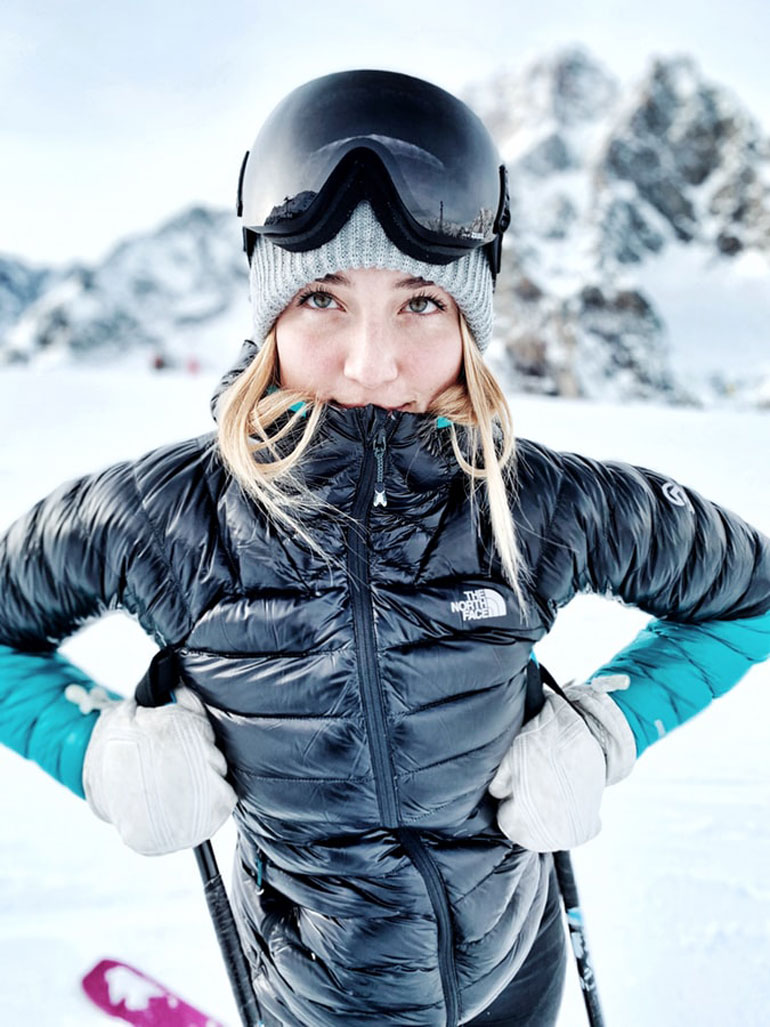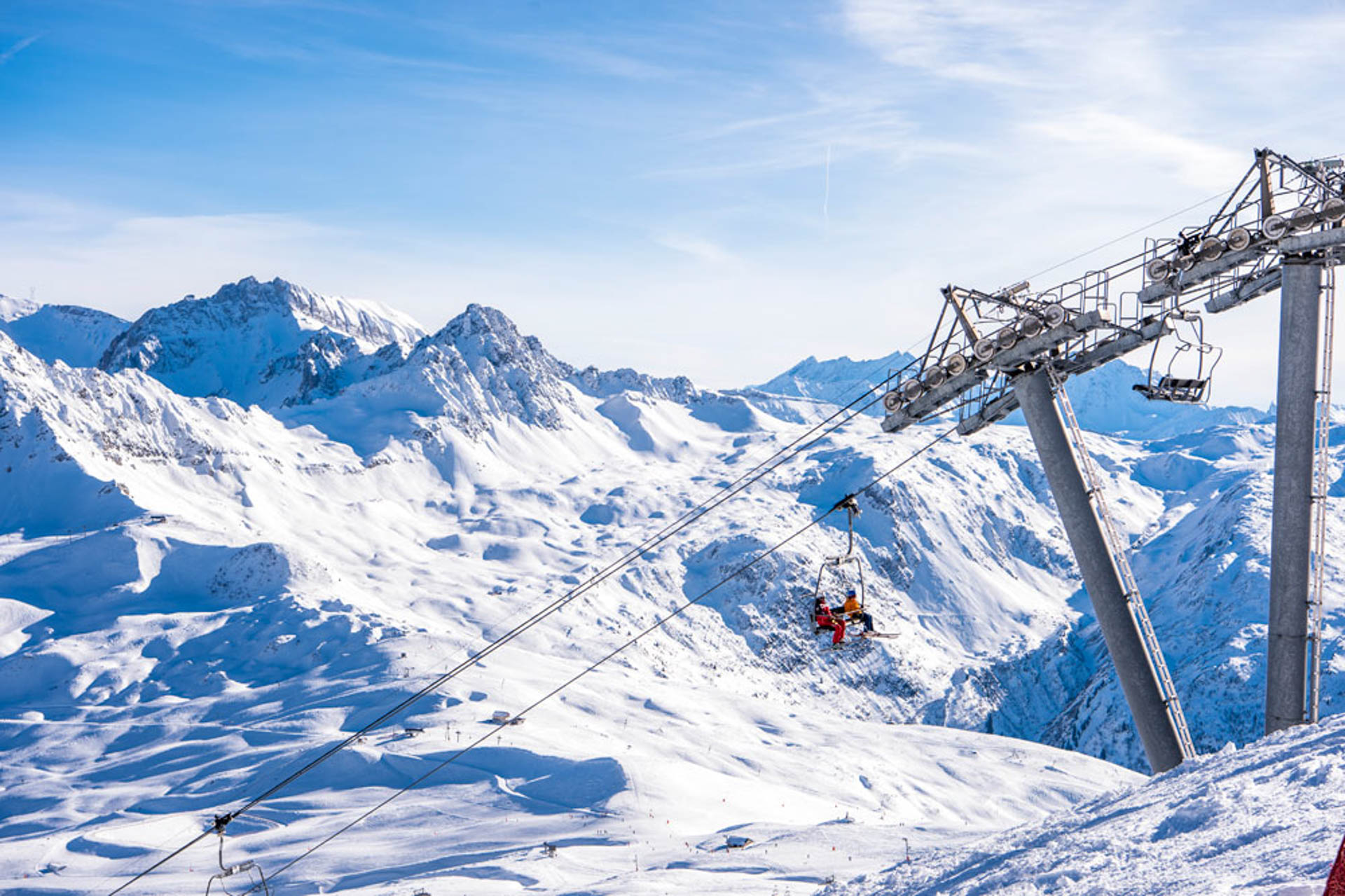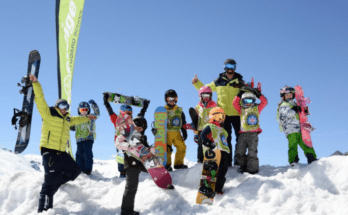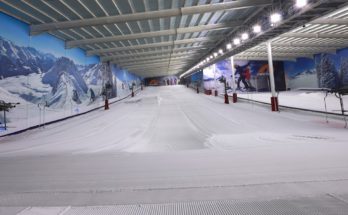
The last thing anyone wants is to be stuck outside in sub-zero temperatures with cold, damp clothes. If it’s your first skiing experience it could even be enough to put you off skiing altogether. Luckily, as the old quote goes, “There’s no such thing as bad weather, only unsuitable clothing.”
If you’re not sure what to wear skiing just follow the tips in this quick ski gear guide. You’ll be sure to stay warm and dry, no matter the weather, so you can focus on what’s important: having fun on your ski holiday!

What should I wear to go skiing?
At its simplest, a good ski outfit boils down to two parts: a good layering system and appropriate accessories.
Dressing in multiple, thin layers helps to trap warm air near your skin and is much, much warmer than just throwing on an enormous jacket and looking like the Stay-Puft Marshmallow Man. You’ll want a minimum of 3 layers. A base layer, a mid layer and a water-resistant ski jacket and salopettes. Add ski socks, gloves, eyewear and headwear and you’ll be ready to tackle even the coldest days on the slopes.
How to Dress in Layers for Skiing
Note: This video is targeted at intermediate-advanced skiers but same principles apply to beginners.
1st Layer – Base Layer

The first thing you’ll want to buy for skiing is a good set of base layers. There are like long underwear, but they aren’t made to keep you warm, they’re made to keep you dry (although that will in turn keep you warm). Made of either synthetic materials like polyester or natural fibres like merino wool, base layers actively transport sweat off your skin so it can evaporate in a process called wicking.
Synthetic base layers are cheaper ranging from €15-60 per item (remember you’ll need both a top and a bottom). Synthetics are moderately better at wicking than base layers made from natural fibres. The downside is that they have a tendency to become smelly quite quickly.
Natural fibres like merino and bamboo are generally more expensive but their natural antibacterial properties keep odours at bay for a long time and they tend to feel better against your skin. Expect to pay €30 to €90 per item.
Avoid cotton at all costs! It will absorb sweat which will sit on your skin and begin to freeze on your next ride up the lift – not a very pleasant experience!
Top tip: You might already own items that can double as base layers like yoga leggings or runner’s compression shirts.
2nd Layer – Mid Layer

On top of your base layer you’ll want to add one or more thin jumpers made of fleece or wool. Ski-specific fleece and wool jumpers abound but unless you’re an advanced skier who needs the highest performance you’ll likely be fine wearing something you already own. Remember that multiple thin layers trap air between them, so two thin jumpers will be warmer than one thick one. It’s worth reminding you once again that cotton and other highly absorbent materials should be avoided. Expect to pay anywhere from €20 for a cheap but effective fleece jumper to €180 for a fancy merino wool number.
On very cold days you might want to add a thin ‘puffer’ jacket, insulated with either down or a synthetic filling. Prices range from around €60 to €400 but you’ll likely want to avoid both ends of that scale. Cheap insulated jackets tend to be both bulkier and less warm than pricier options. On the other hand, once you reach a certain point in the warmth to weight ratio the law of diminishing returns kicks in and you see less and less improvement for your money.
If you (or someone in your group) wears a rucksack up the mountain then you can err on the side of caution and wear an extra jumper in the morning which you can remove if things begin to get too warm.
Note that most people don’t bother with a mid layer on their legs as it’s the legs that do most of the work whilst skiing or snowboarding and tend not to get as cold as the upper body does. That said our content team spend a fair bit of time standing around filming and they swear by their primaloft-insulated shorts.
3rd Layer – Outerwear
 To top everything off you’ll need a weatherproof outer layer to keep the elements out. A good quality ski jacket and salopettes (aka. ski trousers, aka. ski pants) will make sure that wind, snow, sleet and rain stay out while your warmth stays in.
To top everything off you’ll need a weatherproof outer layer to keep the elements out. A good quality ski jacket and salopettes (aka. ski trousers, aka. ski pants) will make sure that wind, snow, sleet and rain stay out while your warmth stays in.
We won’t get in to waterproofing and breathability ratings here but, whether you opt for a shell jacket or a jacket with a bit of built in insulation, you want to make sure your outer layer is a minimum of 5,000 (5k) for both waterproofing and breathability, with higher numbers of 10,000 (10k) and upwards being even more weatherproof.
This layer is generally the most expensive, although you can often find great deals at TK Maxx or on specialist discount sites like SportPursuit. Expect to pay between €50 and €300 on each piece but if you really wanted to you could spend upwards of a couple grand for a set of outerwear.
Tip: If you’re a first-timer remember that your trouser legs and the gaiters inside should go over the cuff of your ski boot. This will keep snow out and prevent chafing.
Ski Accessories
Headwear – A Helmet or a Beanie
 Believe it or not helmets were once a controversial hot topic in the ski industry. Luckily things have calmed down a bit now and wearing a helmet is considered normal even by the most wizened old montagnard. Should you choose to go with a helmet we suggest that you hire one when you rent your skis and ski boots in resort. If you decide that a helmet isn’t for you, a cheap beanie will keep your head nice and toasty.
Believe it or not helmets were once a controversial hot topic in the ski industry. Luckily things have calmed down a bit now and wearing a helmet is considered normal even by the most wizened old montagnard. Should you choose to go with a helmet we suggest that you hire one when you rent your skis and ski boots in resort. If you decide that a helmet isn’t for you, a cheap beanie will keep your head nice and toasty.
Eyewear – Goggles or Sunglasses
 If you’re a beginner, skiing in sunglasses will likely be sufficient as you won’t be going very fast or attacking difficult terrain. On cloudy days however sunglasses can be harder to see in that ski goggles with special lenses made for ‘low-light’ days. Goggles also help keep wind out of your eyes whether that wind is natural or the result of you speeding down the hill. Some ski hire shops will rent goggles but if you choose to buy your own you’ll likely be spending anywhere from €30 – €150.
If you’re a beginner, skiing in sunglasses will likely be sufficient as you won’t be going very fast or attacking difficult terrain. On cloudy days however sunglasses can be harder to see in that ski goggles with special lenses made for ‘low-light’ days. Goggles also help keep wind out of your eyes whether that wind is natural or the result of you speeding down the hill. Some ski hire shops will rent goggles but if you choose to buy your own you’ll likely be spending anywhere from €30 – €150.
Gloves
 There’s no need to go crazy on gloves unless you have very sensitive hands or poor circulation, but they do need to be waterproof! If you arrive in resort to find the weather has taken a turn and it’s going to be -20° every day you can always pick up some cheap disposable hand warming pouches. The main decision you need to make is: mittens or gloves?
There’s no need to go crazy on gloves unless you have very sensitive hands or poor circulation, but they do need to be waterproof! If you arrive in resort to find the weather has taken a turn and it’s going to be -20° every day you can always pick up some cheap disposable hand warming pouches. The main decision you need to make is: mittens or gloves?
Gloves are more versatile as you have additional dexterity for tasks like doing up zippers, whilst mittens will keep your fingers together to trap in your natural body heat. A pair of mitts or gloves suitable for the average skier will cost between €20 and €60.
Socks
 The one and only thing that should ever be worn underneath a pair of ski boots is one pair of ski socks. Don’t wear any old sock you have lying around, especially if they’re made from cotton or really thick. They’ll just absorb sweat and give you cold trench-foot. Also, unless you really enjoy getting blisters, we’d also advise against wearing two pairs of socks in your ski boots. A decent set of ski socks will cost between €12 and €40.
The one and only thing that should ever be worn underneath a pair of ski boots is one pair of ski socks. Don’t wear any old sock you have lying around, especially if they’re made from cotton or really thick. They’ll just absorb sweat and give you cold trench-foot. Also, unless you really enjoy getting blisters, we’d also advise against wearing two pairs of socks in your ski boots. A decent set of ski socks will cost between €12 and €40.
What ski clothing do I need to buy?
Keep in mind, you don’t need to rush out and buy all your ski clothing for your first trip! Beginner skiers and snowboarders are usually much better off trying to borrow kit from a friend who skis (Don’t ask to borrow base layers and socks though, that’s just gross).
After your first ski trip you’ll have a much better idea of exactly what you want and can buy accordingly.
Top tips:
Unless you need something right away, check prices at home before you buy in resort. Although ski equipment and clothing is abundant in resort it will usually also be more expensive than it will be down the mountain, especially in resorts like Gstaad, Val d’Isere and Zermatt.
Brick and mortar discounters like TK Maxx and online discount specialists like SportPursuit are great places to score mega bargains.
Another great way to buy your skiwear is during end of season sales. You’ll save money and you’ll be ready to hit the slopes next winter! You can grab some amazing deals by shopping in April even when in resort, especially in places like Alpe d’Huez, Les Arcs/Bourg Saint Maurice and St Anton.

Get out there!
And just like that you’re all set for your first ski trip! Check out our Ski Trip Packing Checklist to make sure you don’t forget anything on your way out.
If it’s your first trip to the mountains, you’ll definitely want to get yourself some ski or snowboard lessons. Here’s a post on how to choose which type of lessons are best for you.
After you’ve read that, head over to our search page and we’ll make sure you quickly and easily find the perfect ski school or ski instructor to get you going with the best private lessons or group lessons for you. See you on the slopes!





Great advice and content!
Have a great day,
Tim
Great website. Plenty of helpful information here. I’m sending it to several buddies – thank you for your effort!
Very rapidly this web site will be famous among all blog viewers, due to it’s good articles
You actually make it seem so easy!
I am looking forward for your next post, I’ll try to get the hang of it!
Wow, that’s what I was looking for, what a find!
Hi there, You’ve done a fantastic job. I will certainly digg it and personally recommend to my friends.
How thick of jacket for China please?
Hi There! 👋
We recommend a thin shell-type jacket with a good mid-layer jacket underneath. That way you can take off a layer if it gets too hot.
Hope that helps!
Thanks for this – shared to my FB!
Thanks for the tips 🙂
Great advice, thanks SkiBro!
I’ve included this document to my bookmarks
Having read this I believed it was extremely enlightening.
I appreciate you taking the time and energy to put this content together.
I once again find myself spending way too
much time both reading and commenting. But so what,
it was still worth it!